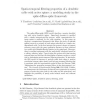Free Online Productivity Tools
i2Speak
i2Symbol
i2OCR
iTex2Img
iWeb2Print
iWeb2Shot
i2Type
iPdf2Split
iPdf2Merge
i2Bopomofo
i2Arabic
i2Style
i2Image
i2PDF
iLatex2Rtf
Sci2ools
JCNS
2006
2006
Spatio-temporal filtering properties of a dendritic cable with active spines: A modeling study in the spike-diffuse-spike framew
The spike-diffuse-spike (SDS) model describes a passive dendritic tree with active dendritic spines. Spine-head dynamics is modeled with a simple integrate-and-fire process, whilst communication between spines is mediated by the cable equation. In this paper we develop a computational framework that allows the study of multiple spiking events in a network of such spines embedded on a simple onedimensional cable. In the first instance this system is shown to support saltatory waves with the same qualitative features as those observed in a model with Hodgkin-Huxley kinetics in the spine-head. Moreover, there is excellent agreement with the analytically calculated speed for a solitary saltatory pulse. Upon driving the system with time-varying external input we find that the distribution of spines can play a crucial role in determining spatio-temporal filtering properties. In particular, the SDS model in response to periodic pulse train shows a positive correlation between spine density a...
| Added | 13 Dec 2010 |
| Updated | 13 Dec 2010 |
| Type | Journal |
| Year | 2006 |
| Where | JCNS |
| Authors | Yulia Timofeeva, Gabriel J. Lord, Stephen Coombes |
Comments (0)

